Carlos Ghosn: How did the Nissan ex-boss flee from Japan?
- Published
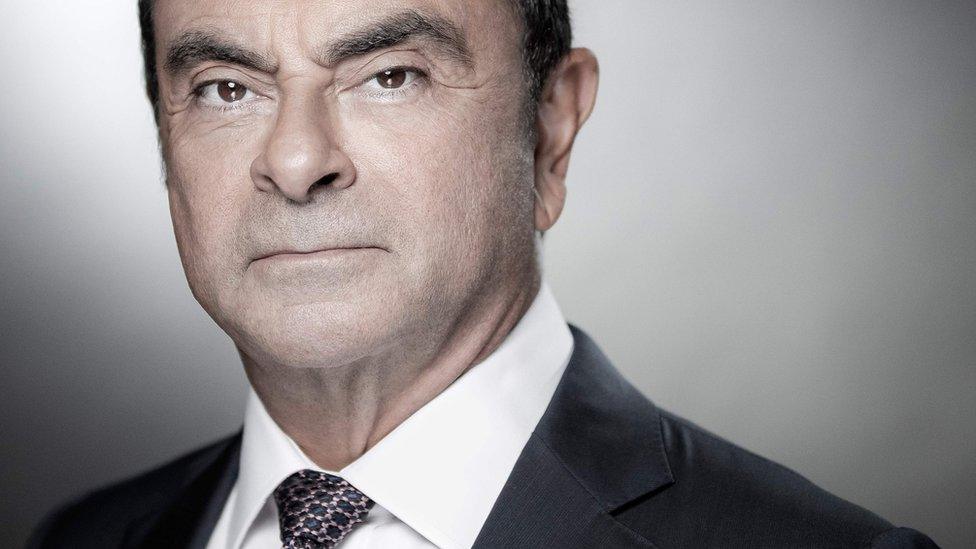
Carlos Ghosn, the former boss of Nissan, managed to leave Japan where he was awaiting trial
He was once a titan of the car industry who held hero status in Japan. He then became one of the country's most well-known criminal suspects. Now he's an international fugitive.
Carlos Ghosn, the multi-millionaire former boss of Nissan, spent months preparing to stand trial on financial misconduct charges. At least, that was what the Japanese authorities were led to believe.
He posted 1bn yen (£6.8m; $8.9m) in bail in April. He was monitored by a 24-hour camera installed outside his house. His use of technology was heavily restricted and he was banned from travelling abroad.
Then, in a move that left Japan red-faced and his own legal team baffled, he appeared in Lebanon on New Year's Eve. "I have escaped injustice and political persecution," he declared in a statement.
"I am dumbfounded," his lawyer, Junichiro Hironaka, told reporters in Tokyo shortly after learning of Mr Ghosn's flight. "I want to ask him, 'How could you do this to us?'"
Another pressing question is: how did he do it at all?
'Mission impossible'
On 8 January, in his first public comments since fleeing, Mr Ghosn refused to say how he managed to leave Japan.
He told a news conference in Beirut that he would clear his name despite being on the run, and joked that he was used to "mission impossible".
Reports suggest that description may not be wide of the mark.
The former CEO's getaway from Tokyo to Beirut was meticulously planned over a period of several weeks or months, according to numerous media reports.
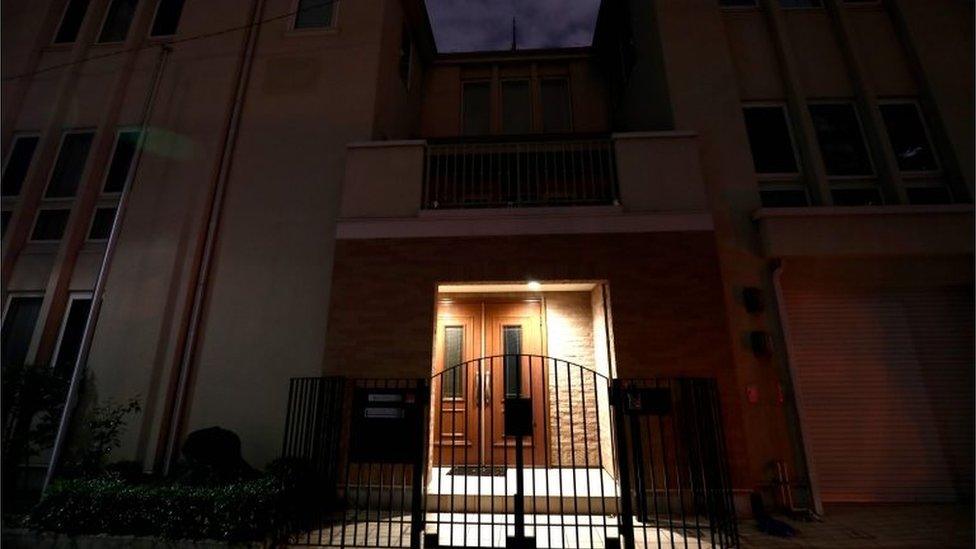
Mr Ghosn walked out of his Tokyo house despite cameras and other security measures
Japanese broadcaster NHK reported that CCTV footage showed Mr Ghosn leaving his house and walking about 800m to a nearby hotel, external in the middle of the afternoon on 29 December. There he joined two men, thought to be Americans.
The three then boarded a train to Osaka and went to a hotel near Kansai international airport. Two hours later, the two men were seen leaving with two large containers, according to NHK. No cameras captured Mr Ghosn - the implication being that he was inside one of the containers.
The Wall Street Journal, citing unidentified sources, said a team was carefully assembled to carry out the plot., external The group reportedly included accomplices in Japan who transported Mr Ghosn from his house and onto a private jet bound for Istanbul. From there, he continued his journey to Beirut where he arrived in the early hours of 30 December.
The plane tracking site FlightRadar24 showed a Bombardier Challenger private jet arriving at Beirut-Rafic Hariri international airport shortly after 04:00 local time. Mr Ghosn then met his wife Carole, who was born in the city and was heavily involved in the operation, the Wall Street Journal says.
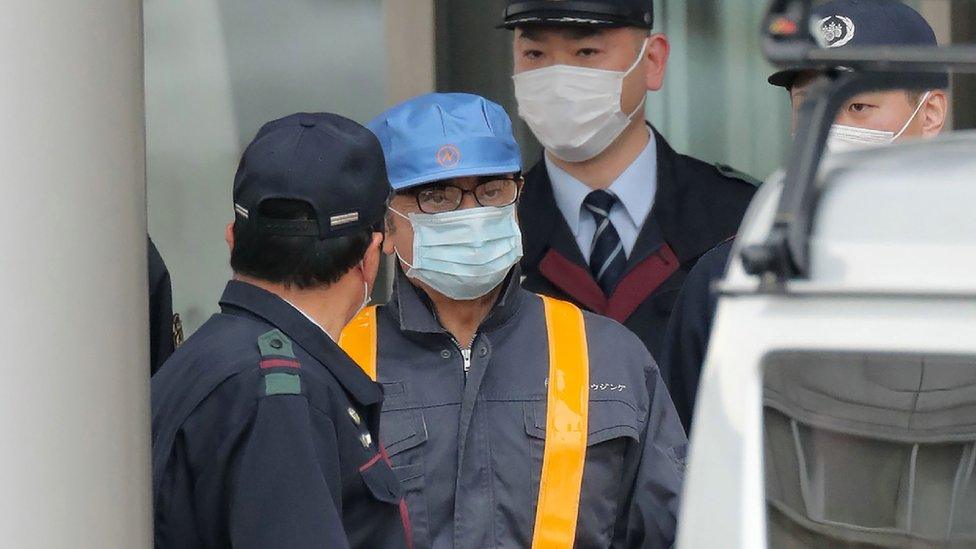
The ex-Nissan boss was pictured leaving prison while disguised as a workman in March 2019
An earlier MTV Lebanon report, which now appears to be inaccurate, suggested Mr Ghosn fled with the assistance of a paramilitary group who were disguised amongst a band of musicians.
The 65-year-old was said to have hid in a large musical instrument case. The broadcaster provided no proof for this theory which, unsurprisingly, spread rapidly across social media.
Mr Ghosn's wife, Carole, told Reuters news agency that reports of the musical escape were "fiction"., external
Donning a spy-movie disguise is not beyond Mr Ghosn, however. In March, in a bid to throw journalists off his scent, he left prison disguised as a construction worker. He was quickly identified and his lawyer soon apologised for the "amateur plan".
The role of Carole Ghosn
Mr Ghosn denies his wife helped him, insisting he organised his escape "alone" and she has declined to provide details of the escape.
But several reports have said Carole Ghosn was a major figure behind the plan for her husband to get out of Japan. She spoke to him for more than an hour on 24 December, Mr Ghosn's Japanese lawyer said. The couple had previously been banned from meeting or communicating under Mr Ghosn's bail conditions.
After her husband arrived in Lebanon, Mrs Ghosn told the Wall Street Journal that their reunion was "the best gift of my life".
Mr Ghosn's wife Carole told the BBC in June that Japanese officials were trying to humiliate her husband
Mr Ghosn has repeatedly denied any wrongdoing. He has also said media speculation that his wife had played a role in his escape was "inaccurate and false", adding: "I alone arranged for my departure."
Several media reports said private security operatives helped smuggle Mr Ghosn out of house arrest.
The Financial Times reported that the operatives had been planning the escape for months,, external and had allegedly split into several teams working in different countries. Two people familiar with the situation said the preparations were assisted by Mr Ghosn's Japanese supporters.
The former Nissan boss made his escape by flying out of Japan's Osaka airport on a private jet, the newspaper reported. It said Mr Ghosn was not required to wear any electronic tags while on bail.
Two unnamed sources close to Mr Ghosn told Reuters news agency that even the pilot of the private jet was unaware of Mr Ghosn's presence on board, external.
Three passports
Questions remain about the documents Mr Ghosn used to enter Lebanon. He holds three passports - Brazilian, French and Lebanese - but his legal team maintain that they were in possession of all of them when he left Japan.
It is not known whether Mr Ghosn was holding duplicate passports - as businesspeople are sometimes allowed to do. It has also been reported that he may have had a diplomatic passport issued by Lebanon although this has not been confirmed.
While the French newspaper Le Monde said he travelled on an ID card, others have reported that he may have used a French passport or even forged documents.
A spokesperson for Mr Ghosn told the Financial Times he had used a French passport to enter Lebanon but would not disclose how he had left Japan.
Ghadi Khoury, from the Lebanese foreign ministry, said the former Nissan boss had entered the country on a French passport and Lebanese ID, according to the newspaper.
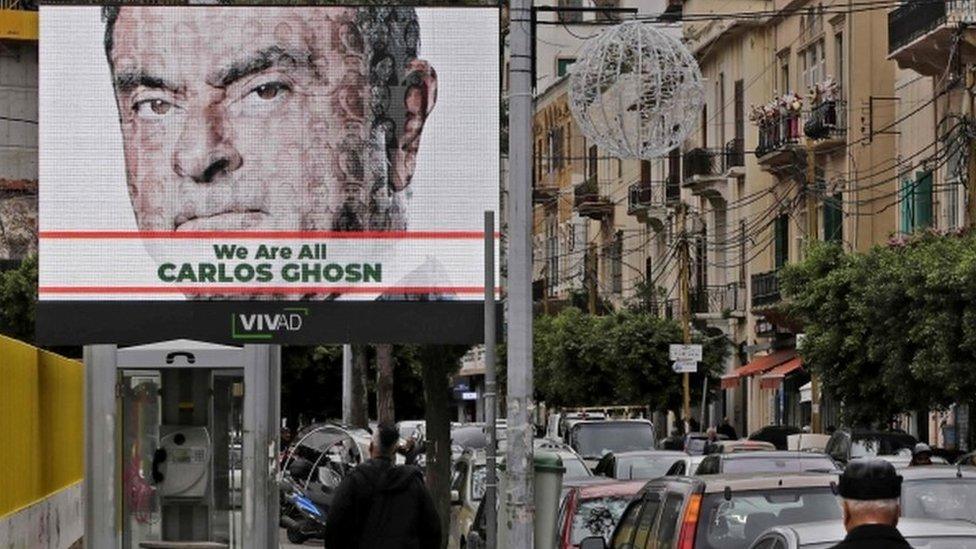
Mr Ghosn grew up in Beirut and remains a popular figure in the city
The embarrassment caused by Mr Ghosn's flight soon sparked a reaction from Japan. One Japanese politician asked whether he "had the support of some country". A former governor of Tokyo was more forthright, accusing Lebanon of direct involvement.
Mr Ghosn grew up in Lebanon, owns property there and is a popular figure. He even appeared on one of the country's postage stamps.
The two Reuters sources said the Lebanese ambassador to Japan had visited him every day while he was in detention. The ambassador has not publicly responded to this claim.
The Lebanese government has denied any involvement in Mr Ghosn's escape.
"The government has nothing to do with [Mr Ghosn's] decision to come," Lebanese minister Salim Jreissati was quoted as saying by the New York Times., external "We don't know the circumstances of his arrival."
Mr Khoury told the Financial Times that Lebanon "had asked for [Mr Ghosn's] extradition", but said the government had not had any involvement in his plan to escape.
France and Turkey have also said they were unaware of Mr Ghosn's plan.
What now?
On 2 January Lebanon received a "red notice" from Interpol for Mr Ghosn's arrest - a request to detain a person pending extradition, surrender or other legal action. However, there is no extradition deal between Japan and Lebanon.
France, meanwhile, has said it would not extradite him if he arrived in the country as he is a French citizen.
Turkey has launched an investigation into Mr Ghosn's reported stopover in Istanbul. Local media say seven people have been arrested - four pilots, a cargo company manager and two airport workers.
Japan gives millions in aid to Lebanon and is likely to want Mr Ghosn returned. But it faces questions about how such a high-profile suspect was able to get out of the country in the first place.
- Published31 December 2019

- Published24 October 2019
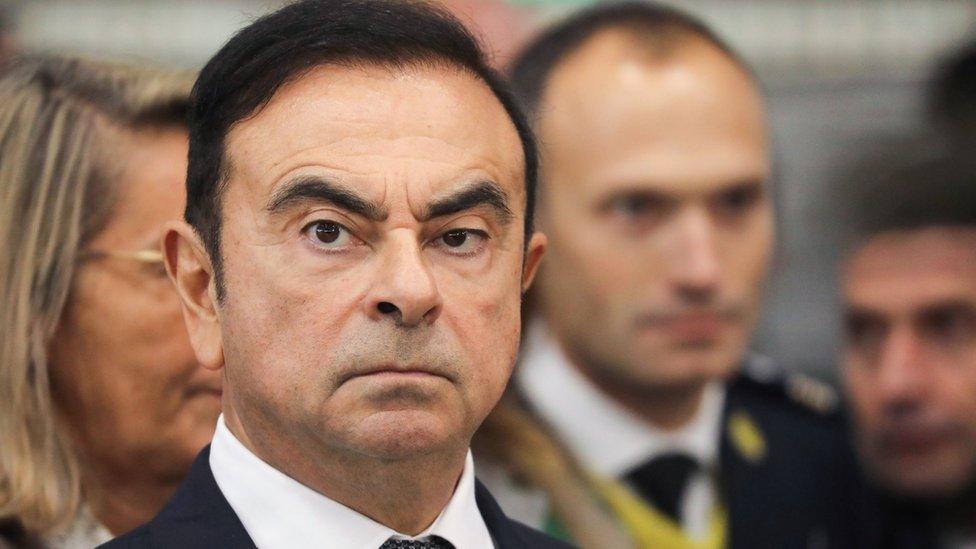
- Published6 March 2019
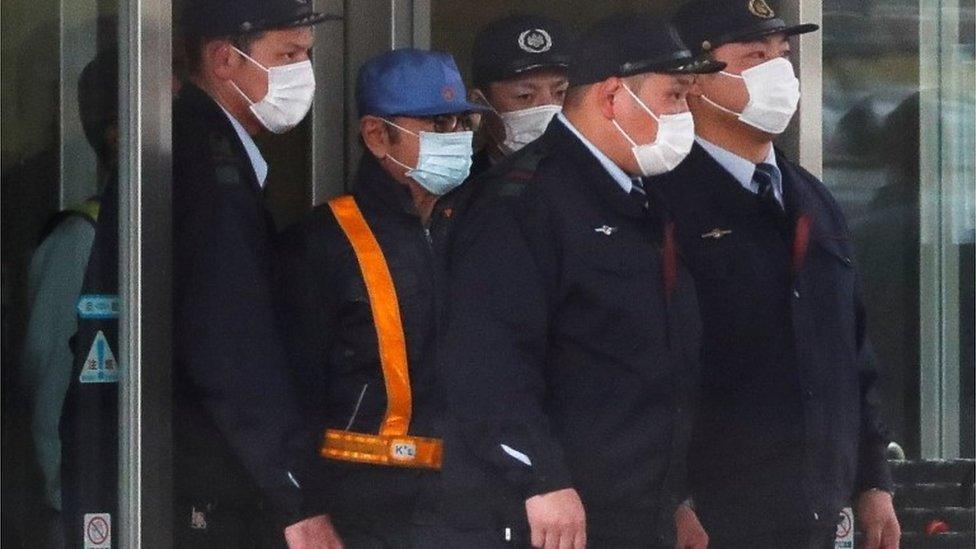
- Published19 November 2018
